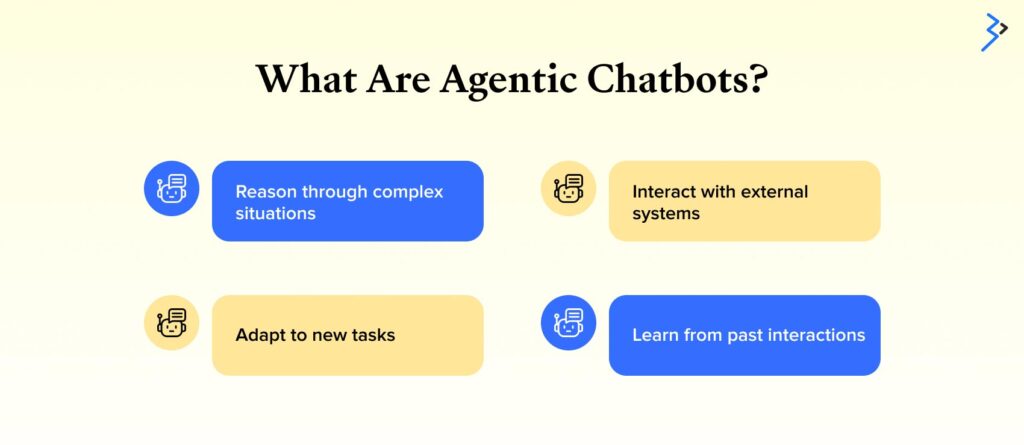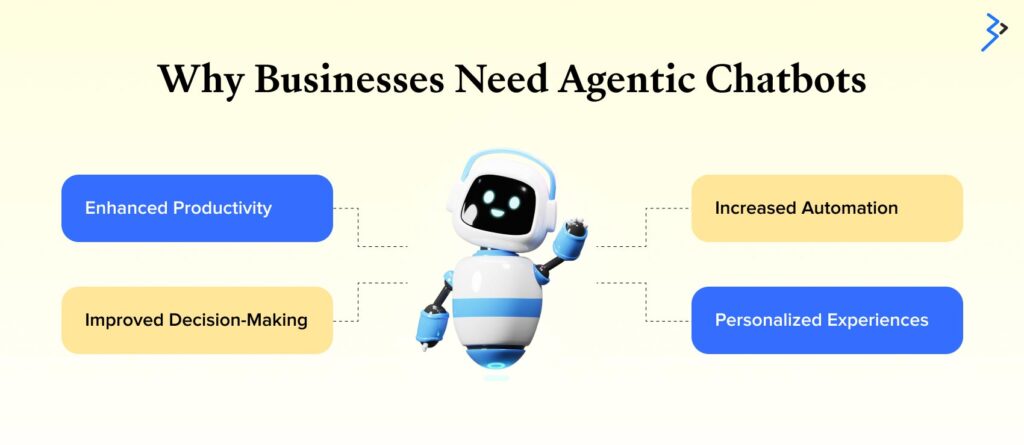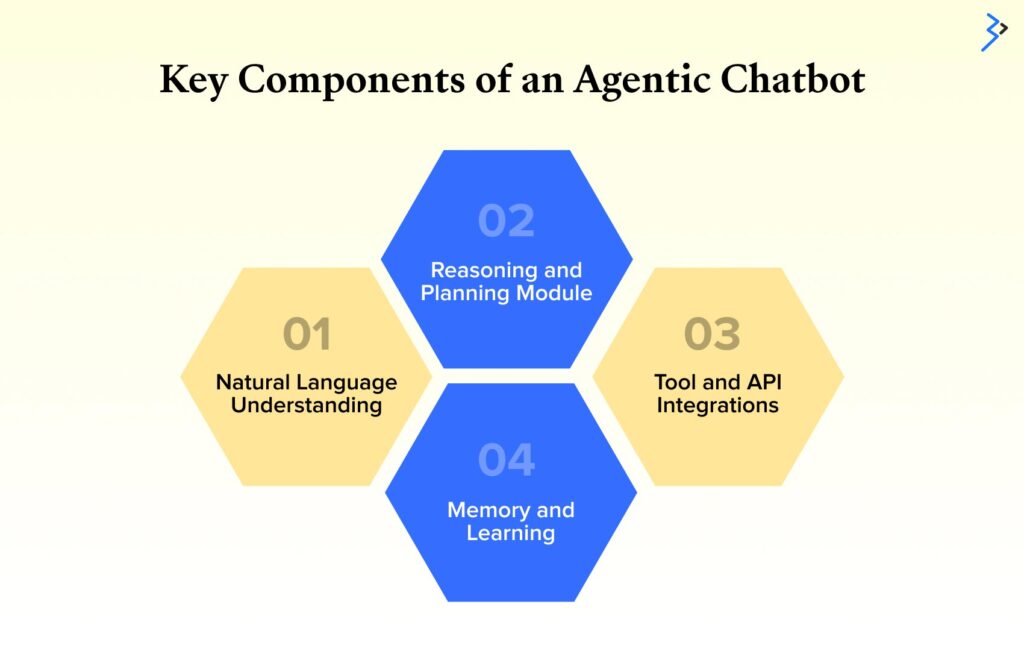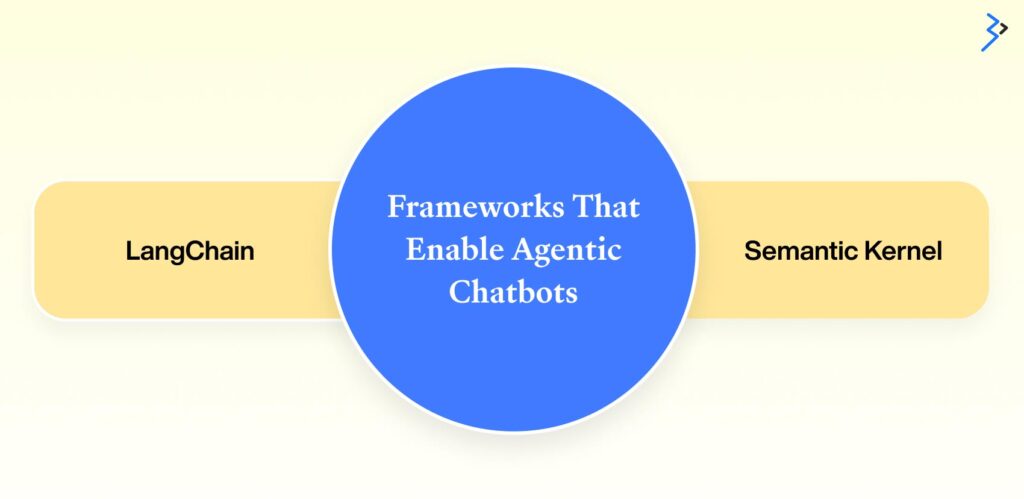Artificial intelligence is undergoing rapid change as new technologies transform how people engage with digital platforms. Agentic AI is a new strategy that is causing a stir in the business; it’s a cutting-edge method that empowers digital agents to act and decide independently.
However, the next frontier in chatbot technology lies in agentic chatbots — systems that combine reasoning capabilities with external tool access, unlocking more dynamic and intelligent interactions.
What Are Agentic Chatbots?

Agentic chatbots represent the next evolution of AI, designed to think, plan, and act independently. Unlike traditional bots that follow pre-set scripts or decision trees, agentic chatbots possess advanced reasoning and problem-solving abilities.
They can:
- Reason through complex situations — analyze multiple factors to determine the best action.
- Interact with external systems — connect to APIs, databases, and third-party tools for real-time data retrieval and updates.
- Adapt to new tasks — handle unfamiliar requests without needing reprogramming.
- Learn from past interactions — continuously improve by recognizing patterns and refining responses.

This allows agentic chatbots to respond to user input and proactively handle tasks. For example, they can schedule appointments by cross-checking availability, conduct research by pulling data from multiple sources or generate personalized recommendations by understanding user preferences.
Whether enhancing customer experiences or optimizing internal workflows, agentic chatbots are reshaping how businesses operate — delivering smarter, faster, and more personalized support with minimal human intervention. They’re not just conversational tools but intelligent digital assistants driving efficiency and innovation.
Read More-: Elevate your Adobe Experience Manager Sites Website with Generative AI Chatbots
Why Businesses Need Agentic Chatbots

Agentic chatbots offer significant advantages for businesses aiming to elevate customer experience and streamline internal processes. Unlike traditional bots, they go beyond basic responses — handling complex tasks, adapting to context, and providing proactive support.
Here’s a breakdown of their key benefits:
| Advantage | Description |
| Increased Automation | Handles multi-step tasks like data retrieval, order processing, and scheduling without human input. |
| Personalized Experiences | Pulls data from CRMs, past interactions, and browsing history to tailor recommendations and responses. |
| Enhanced Productivity | Reduces human workload by managing repetitive tasks, freeing staff for more strategic activities. |
| Improved Decision-Making | Provides context-aware insights, helping businesses make faster, more informed decisions. |
Key Components of an Agentic Chatbot

An agentic chatbot stands apart from traditional bots by exhibiting autonomy, adaptability, and advanced problem-solving capabilities. To achieve this, it combines several sophisticated components that work together seamlessly. Let’s explore the key elements that define an effective agentic chatbot:
1. Natural Language Understanding (NLU)
The cornerstone of any chatbot is its ability to comprehend user input accurately — and this is where Natural Language Understanding (NLU) comes into play. Modern agentic chatbots leverage advanced deep learning models, like GPT-4, to process not just the words but the context, intent, and sentiment behind user messages.
This allows the bot to interpret complex queries, handle ambiguous language, and deliver more human-like and intuitive responses. For example, if a user asks, “What’s the weather like in New York tomorrow?” an agentic bot doesn’t just recognize keywords — it understands the intent is to retrieve and relay weather data for a specific location and time.
2. Reasoning and Planning Module
A defining feature of an agentic chatbot is its ability to reason and plan — essentially, to “think.” This component allows the bot to break down multi-step requests, prioritize tasks, and execute actions in a logical order. Imagine a user asking, “Can you book a flight for Saturday, find a hotel nearby, and schedule a taxi from the airport?” A basic bot might stumble, but an agentic chatbot parses this into three sub-tasks: flight booking, hotel search, and taxi schedules.
It then determines the optimal sequence, ensuring the hotel is near the event location, and the taxi aligns with the flight’s arrival time. This kind of dynamic planning creates a smoother, more effective user experience — mimicking the cognitive abilities of a human assistant.
3. Tool and API Integrations
One of the most powerful features of agentic chatbots is their ability to integrate with external tools and APIs. This functionality transforms the chatbot from a passive responder into an active, capable assistant. By connecting to various systems, agentic chatbots can:
- Retrieve real-time information — like weather updates, stock prices, or order tracking.
- Interact with productivity platforms — such as Google Calendar, email services, or Customer Relationship Management (CRM) systems to schedule meetings, send reminders, or log customer data.
- Access databases — to provide tailored recommendations, whether it’s suggesting a product based on past behavior or pulling up a user’s saved preferences.
These integrations allow the chatbot to act on the user’s behalf, creating a truly hands-free, automated experience.
4. Memory and Learning
Memory and learning capabilities are essential for an agentic chatbot to feel truly intelligent and personalized. Short-term memory helps maintain context within a conversation — preventing the bot from resetting with every new input — while long-term memory allows it to retain user preferences, past interactions, and behavioral patterns over time.
For instance, if a user consistently books window seats on flights, the chatbot can remember this and automatically apply the preference to future bookings. Moreover, through continuous learning, the chatbot adapts to new information, refines its responses, and becomes more effective with each interaction.
Read More-: Best Gen-AI-Based Customer Service Chatbots
Frameworks That Enable Agentic Chatbots

Building an agentic chatbot from scratch can be complex. Thankfully, frameworks like LangChain and Semantic Kernel simplify the process by providing prebuilt components and workflows.
LangChain
LangChain is an open-source Python framework designed for building advanced AI-driven applications, particularly those that need reasoning and external tool integration. Key features include:
- Prompt chaining: Connects multiple steps into a coherent reasoning flow
- Memory management: Supports short-term and long-term context retention
- Toolkits: Easily integrate APIs, databases, and other resources
LangChain’s modular approach makes it ideal for creating multi-functional chatbots — like one that can pull sales data, summarize insights, and draft follow-up emails.
Semantic Kernel
Developed by Microsoft, Semantic Kernel focuses on enabling AI to perform autonomous tasks. It supports:
- Skill chaining: Connects various “skills” (small functions) into a larger process
- Planner API: Helps the chatbot plan its approach to complex queries
- Integration-friendly: Seamlessly works with .NET and Python environments
Semantic Kernel is particularly useful when businesses want their chatbot to blend AI reasoning with backend processes — think generating dynamic reports or automating ticketing systems.
Real-World Use Cases
Agentic chatbots redefine how businesses engage with customers, streamline operations, and enhance user experiences. Unlike traditional bots, these advanced systems make decisions, adapt to changing scenarios, and take proactive actions — mimicking human-like reasoning. Let’s explore how they’re transforming key industries:
1. eCommerce Personal Shopping Assistants
In eCommerce, personalization drives sales. Agentic chatbots go beyond basic product recommendations by acting as virtual shopping assistants. They can:
- Understand user preferences — analyze past behavior to determine size, color, style, and budget preferences.
- Check inventory across suppliers — ensure the desired item is available from various warehouses.
- Compare prices — find the best deals across multiple vendors.
- Suggest alternatives — if an item is out of stock or over budget, the bot proposes similar, in-stock products.
This level of support helps customers find the perfect item faster while reducing cart abandonment.
2. Healthcare Appointment Scheduling
Scheduling medical appointments is often a tedious process. Agentic bots revolutionize this by managing the entire workflow. They can:
- Verify insurance details — check coverage and eligibility before booking.
- Check doctor availability — scan real-time schedules to find suitable slots.
- Book appointments — confirm visits seamlessly without human intervention.
- Send reminders and handle rescheduling — ensure patients don’t miss appointments while allowing easy rescheduling if needed.
This automation boosts clinic efficiency and ensures patients receive timely care without long phone calls.
3. Travel Planning Assistants
Travel planning is complex, especially for multi-city itineraries or last-minute changes. Agentic chatbots simplify this by offering comprehensive, adaptable travel support:
- Plan multi-city itineraries — create personalized routes based on user preferences, layovers, and budget.
- Compare flight and hotel packages — find the best deals in real-time.
- Retrieve local recommendations — suggest restaurants, activities, and transportation options.
- Handle last-minute changes — rebook flights, hotels, or activities if plans shift unexpectedly.
This approach mimics the expertise of human travel agents, offering personalized, flexible support around the clock.
4. Technical Support and IT Automation
In IT environments, downtime is costly. Agentic chatbots speed up troubleshooting and reduce manual intervention by:
- Diagnosing issues — analyze error logs and user inputs to identify the root cause.
- Recommending solutions — suggest fixes based on knowledge bases and past incidents.
- Triggering automated fixes — autonomously perform basic resets, configuration changes, or software patches.
- Escalating to human agents — involve specialists only when the problem is too complex for automation.
This ensures faster resolutions, reduced IT workload, and improved system reliability.
Agentic chatbots are more than conversational tools—they’re decision-makers, problem solvers, and proactive assistants. They’re reshaping industries from e-commerce and healthcare to travel and IT support by handling complex, multi-step tasks with minimal human input. These bots will become even more intuitive, adaptive, and essential to modern business operations as technology advances.
Read More-: Chatbots and Their Impact on Customer Support
The Future of Agentic Chatbots
As technology evolves, so will agentic chatbots. Some upcoming trends include:
- Multimodal AI: Combining text, voice, and vision for richer interactions
- Federated learning: Enabling chatbots to learn across devices without compromising privacy
- Emotion detection: Enhancing empathy by understanding emotional cues
- Real-time adaptation: Adjusting conversational tone or strategy mid-interaction
Final Thoughts!
Agentic chatbots are redefining AI-powered interactions. By integrating reasoning capabilities and external tool access, they go beyond basic automation to solve problems, enhance user experiences, and boost productivity.
Frameworks like LangChain and Semantic Kernel make development more accessible, so businesses of all sizes can harness this technology to stay competitive and innovative.The future of chatbots isn’t just about conversation — it’s about action, reasoning, and dynamic problem-solving. Are you ready to build your agentic chatbot?
Related Articles
-
Top Generative AI Content Writing Tools for 2025
Generative AI tools are transforming content creation across multiple industries by offering innovative solutions that enhance productivity and creativity. These tools assist marketers, writers, and businesses in producing high-quality content
-
Driving Efficiency By Harnessing AI for Cloud Optimization
AI in cloud computing enhances security measures, proactively identifying and mitigating threats before they can impact operations. This level of protection is crucial in today’s digital landscape, where cyber threats
-
Crafting Perfection: AI’s Impact on the Jewelry Industry
The jewelry industry has long been revered for its artistry and attention to detail in the world of luxury and craftsmanship. However, as technology continues to advance, artificial intelligence (AI)




